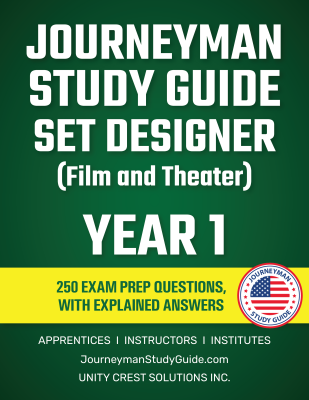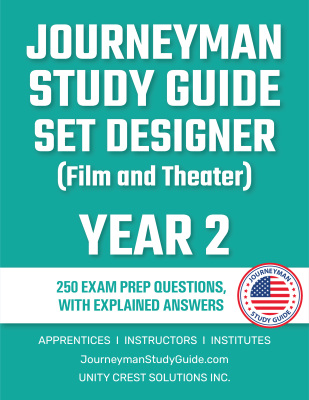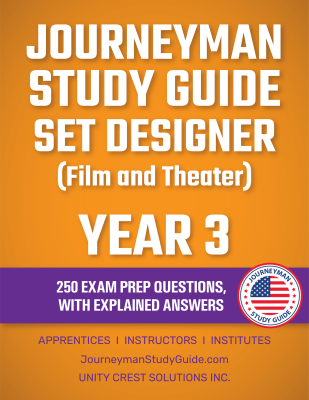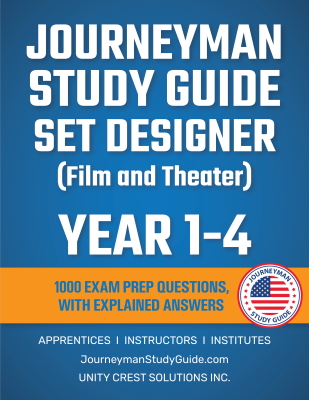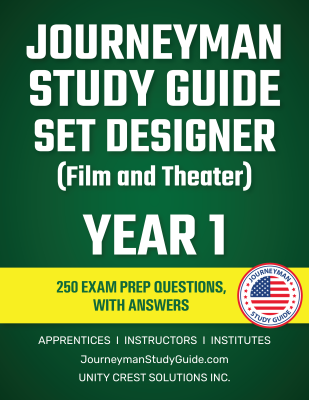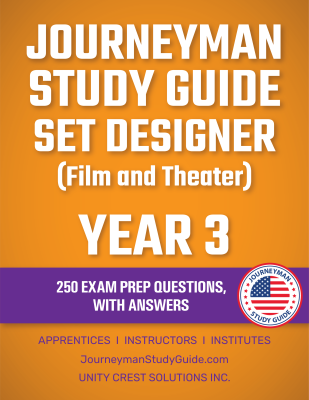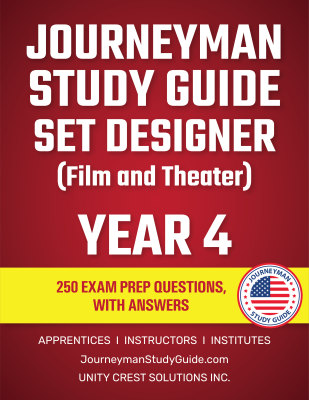Questions, Answers, & Explanations
Get clear explanations behind every answer, perfect for deeper learning and more thorough exam preparation.
Site Updates in Progress: Things might look different as we work on enhancing your experience.
A Set Designer, also known as a Scenic Designer, is a creative professional responsible for designing the physical environments where stories unfold in film, television, and theater productions. Their work transforms scripts into immersive settings that support storytelling, evoke emotions, and establish the mood and context of a production.
What Does a Set Designer Do?
Set Designers play a crucial role in the visual storytelling process by creating the physical surroundings in which the narrative unfolds. They collaborate closely with directors, producers, and other creative team members to conceptualize and construct scenic elements that enhance the story's mood, period, and location. This involves designing the physical layout and appearance of the set, considering how these elements interact with lighting, sound, and props to create a cohesive and believable environment. They often attend rehearsals or on-set shoots to ensure the set functions smoothly during performance or filming. Set Designers may also need to adjust their designs on short notice based on script changes or directorial feedback. Flexibility, quick problem-solving, and teamwork are vital in this fast-paced environment. (Americans for the Arts)
Key responsibilities include:
Skills and Tools
Set Designers blend artistic vision with technical proficiency. Essential skills include:(Diversity Jobs)
Common tools and software used by Set Designers include:
Work Environment
Set Designers work in diverse settings, including:
They may be employed full-time by production companies or work as freelancers, taking on projects as needed. The role often involves irregular hours, including evenings and weekends, to meet production schedules.
Career Path and Opportunities
Aspiring Set Designers typically pursue education in theater design, architecture, or related fields. Gaining experience through internships, assistant roles, or community theater can be valuable. With experience, Set Designers may advance to roles such as Production Designer or Art Director. Building a strong portfolio with visual samples of past projects is essential for standing out in this competitive field. Many professionals also benefit from joining industry groups like the United Scenic Artists union.
The demand for Set Designers varies by region and industry. In the United States, opportunities are concentrated in entertainment hubs like Los Angeles and New York City. The U.S. Bureau of Labor Statistics projects steady employment for Set and Exhibit Designers, with a focus on those who can adapt to digital technologies and sustainable practices.
Conclusion
Set Designers play a crucial role in bringing stories to life through visual environments. Their work enhances narratives, supports actors' performances, and immerses audiences in the world of the production. For those with a passion for art, storytelling, and collaboration, a career in set design offers a dynamic and rewarding path.
Becoming a Set Designer for film or theater in the United States does not require a standardized licensing exam. However, many employers look for candidates with a solid foundation in design principles, safety knowledge, and technical skills. While it’s not required by law, having certifications or a relevant degree can make a big difference when applying for work in this competitive industry. Many professionals choose to earn credentials that prove their understanding of the field, especially in large markets like New York or Los Angeles.
No National Exam, But Education and Certifications Help
Unlike some trades, there is no single Red Seal–style or national exam for Set Designers in the U.S. Instead, aspiring professionals usually build a strong resume through education, internships, and project work. Many start with a bachelor’s degree in theater design, architecture, interior design, or fine arts. Some also study scenic design in specialized programs offered at universities and art schools.
Although there is no required exam, there are certification programs that test your knowledge in stagecraft, safety, and the use of design tools. These credentials are often optional but recommended for those who want to show their commitment and skill to employers in the entertainment industry.
Certifications That Can Boost Your Career
One of the most recognized certifications is the eSET (Essential Skills for Entertainment Technicians) offered by the United States Institute for Theatre Technology (USITT). This certification tests basic knowledge across several areas that are important for entry-level technicians, including set design. The eSET exam is multiple choice and covers safety practices, stage directions, job roles, and other essential topics.
Another useful credential is the ETCP (Entertainment Technician Certification Program), which focuses on rigging, electrical, and related safety standards. While it’s not specific to set design, understanding the technical systems behind a stage or film set can help set designers work better with crew members.
You don’t have to take these exams to work as a Set Designer, but many hiring managers will view certifications as a sign of dedication and professionalism. Plus, these programs can teach you valuable safety knowledge that keeps you and your crew safe during production.
What You’ll Be Tested On (If You Take a Certification Exam)
If you choose to pursue a credential like eSET or ETCP, here are some of the topics you might encounter:
Most exams are online or held at approved testing centers. Some programs also offer study guides, workshops, or training sessions to help you prepare.
How to Prepare for Certification
If you decide to get certified, you’ll need both hands-on experience and some studying. Start by reading up on stage safety and scenic design through books, online courses, or YouTube tutorials. Look for workshops hosted by USITT or regional theater groups. If you’re still in school, ask your instructors about preparing for these certifications—some colleges even include exam prep in their curriculum.
Networking also helps. Join professional groups or online communities where other designers share exam tips, study guides, and portfolio advice. Being connected to others in the field can help you stay current on which credentials are most respected in your region or industry niche.
Summary
There’s no single exam you must pass to become a Set Designer in the U.S., but pursuing voluntary certifications can help show that you’re serious about the craft. Programs like eSET and ETCP can teach you practical safety knowledge and technical terms that are used on real sets. Combined with a good education and a strong portfolio, these certifications can set you apart when applying for jobs in theater, film, television, or live events. While exams aren’t required, they’re a smart step for those who want to advance their careers in a highly visual and collaborative industry.
If you're preparing to become a Set Designer in film or theater, you may wonder what kind of exam questions you might face. While there is no official government-issued licensing exam for Set Designers in the United States, many schools, unions, and certification bodies do assess your knowledge through tests, interviews, or portfolios. These assessments often focus on your design skills, safety awareness, technical understanding, and ability to work as part of a creative team.
If you pursue a credential like the eSET (Essential Skills for Entertainment Technicians) or a college-level design program, you can expect written and practical questions that test your readiness for real-world work in film, theater, or television.
Types of Questions You Might Face
Questions for Set Designers can vary depending on the organization or institution offering the exam or interview. However, most follow a few key themes. Below are the common categories along with example question types.
1. Design and Visual Concepts
These questions assess your understanding of how to design a set that fits the mood, story, and setting.
These questions may be open-ended or involve reviewing a script excerpt and describing your design choices.
2. Technical and Structural Knowledge
This part covers construction materials, safety, measurements, and tool use.
Some questions may be multiple-choice, while others may require short written responses or diagrams.
3. Stage and Film Terminology
These test your knowledge of professional language used in productions.
These are usually multiple-choice or true/false style to quickly check your familiarity with industry jargon.
4. Digital Tools and Software
Many assessments will ask about your experience with digital design tools.
You may be shown a screenshot and asked to identify or troubleshoot an error.
5. Safety and Collaboration
Safety is always important in theater and film. These questions ensure you understand best practices on set.
Questions can also be scenario-based, testing your ability to make decisions under pressure.
Question Formats
Depending on the institution or test provider, the exam questions might appear in one or more of the following formats:
Programs like eSET (offered by USITT) use 100 multiple-choice questions, and some schools use written design projects as part of their final evaluation.
Practice and Preparation
To get ready for these types of questions, study the basics of scenic design, stagecraft, and safety procedures. Review terminology, read scripts, and try sketching sample set layouts. You can also find practice quizzes online or purchase study guides for entertainment technicians. Some schools and workshops offer mock exams, which can be a great way to test your readiness.
Final Thoughts
Even though there is no one national exam for Set Designers in the U.S., being prepared for test-style questions is important if you’re going through a certification program, a job interview, or a college assessment. Most of the questions focus on real-world knowledge—how to design, build, and manage a set safely and creatively. With solid study habits and hands-on experience, you’ll be ready to succeed in any test that comes your way.
A day in the life of a Set Designer in film or theater is both creative and technical. These professionals are responsible for shaping the physical world where the story takes place. Their job goes beyond sketching ideas—they must manage time, communicate with teams, solve problems, and keep up with production schedules. Set Designers work in different environments, such as theaters, film studios, or even outdoor sets. Whether they’re designing for a Broadway play or a Hollywood movie, the day is always filled with fast-paced tasks that require focus, imagination, and teamwork.
Early Morning – Reviewing and Planning
Most Set Designers start their day early, especially if they’re working on a tight deadline. The morning often begins by reviewing their schedule, checking emails, and going over any notes from the director or production team. If they're in the middle of designing a new set, they might begin sketching ideas or updating digital drawings using software like AutoCAD or SketchUp.
Planning is a big part of the job. The Set Designer might make a checklist for the day, prioritizing tasks like material selection, construction updates, or meeting with the crew. During this time, they’ll also review the script again to make sure the set design reflects the story’s location, mood, and time period.
Mid-Morning – Team Collaboration
Around mid-morning, Set Designers usually meet with other departments. They may sit down with the director, costume designer, lighting designer, and stage manager. These meetings are important because the set needs to match the lighting design, costume style, and actor movement. In film, this might also include meetings with the cinematographer and production designer.
Set Designers explain their vision using sketches, models, or mood boards. They need to answer questions, take feedback, and sometimes adjust their design based on the director’s ideas or budget changes.
Noon – Visiting the Build Site or Workshop
After meetings, Set Designers often visit the set construction area. In theater, this could be backstage or in a scene shop. In film, it might be a studio lot or location shoot. Here, they check in with the construction crew or scenic artists who are building the set pieces.
They make sure that everything is being built according to the plans and that materials are being used correctly. If something doesn’t look right or doesn’t fit the space, they may need to make quick design changes on the spot. They also ensure that all safety standards are being followed.
This part of the day is very hands-on. Set Designers measure pieces, take photos, and might even help with painting or layout. They need to be flexible and ready to solve problems quickly.
Afternoon – Design Adjustments and Budget Checks
Back at their desk or studio, Set Designers spend the afternoon updating drawings, adjusting budgets, and preparing for the next phase of production. They may need to revise the design to fit changes in the script, a new camera angle, or a cost limit. Budgeting is a big part of the job. Designers often compare prices for materials and make choices based on quality, safety, and cost.
They might also create new documents for the construction crew, such as blueprints or instructions. Good communication is essential so that everyone involved knows exactly what to do.
Late Day – Review and Prep for Tomorrow
Toward the end of the day, Set Designers review the progress made and plan for the next steps. They might email updates to the director, check in with the team, or look at how the set fits with other design elements like props and lighting.
If a production is about to start filming or rehearsing, they may attend technical run-throughs or rehearsals to see how the actors interact with the set. This helps identify issues like blocked sightlines, awkward set pieces, or safety concerns.
Conclusion
A Set Designer’s day is filled with variety. They sketch, plan, build, meet, and adjust. Every day brings new challenges, but also creative opportunities. Whether working in theater or film, these designers are key members of the production team. Their work helps bring the script to life and create the visual world the audience will experience. For those who enjoy design, teamwork, and problem-solving, it’s a fast-paced and rewarding career.
Becoming a Set Designer for film or theater is a rewarding journey for anyone who enjoys creativity, storytelling, and hands-on work. This career path doesn’t follow one set route. People enter the field from different directions—some through art, others through architecture or theater. What’s important is building the right skills, gaining experience, and creating a strong portfolio that shows your vision and technical ability. The path may take time, but it offers exciting opportunities in the entertainment industry.
Step 1: Education and Training
Most Set Designers start by getting an education in a related field. A bachelor’s degree in scenic design, theater arts, fine arts, architecture, or interior design is a common first step. Many universities and art schools in the U.S. offer specialized programs in set or scenic design. These programs teach drawing, drafting, model-making, design software, and theater history.
Some schools also provide opportunities to work on student plays or short films, which helps students gain real experience while building their portfolios. A few Set Designers may also go on to earn a master’s degree, but it’s not required for most jobs.
In addition to formal education, there are certificate programs and workshops offered by professional organizations like the United States Institute for Theatre Technology (USITT). These programs focus on industry skills such as safety, construction basics, and collaboration with other departments.
Step 2: Internships and Assistant Roles
After or during school, aspiring Set Designers often work as interns or assistants on theater or film productions. These entry-level positions are important because they offer practical, hands-on experience. Interns might help with painting scenery, building props, or assisting with set installation.
Assistant Set Designer roles are a great next step. In this position, you work under a more experienced designer, helping them with research, drafting, and construction details. This is where you start to learn how a real production works and how to solve problems on the job.
Step 3: Building a Portfolio and Making Connections
A strong portfolio is one of the most important tools for a Set Designer. Your portfolio should include sketches, models, digital renderings, and photos of completed sets. It shows directors and producers what you can do.
Networking is also key in this career. Joining theater groups, attending film festivals, or becoming part of professional organizations can help you meet people in the industry. Many jobs in film and theater come from word-of-mouth or referrals, so building relationships matters.
Step 4: Working Independently or Full-Time
Once you gain enough experience and have a solid portfolio, you can start taking on jobs as a freelance Set Designer or apply for full-time positions with production companies, theaters, or television studios. Many designers work on contract-based projects, moving from one show or film to another.
In the theater world, you might work for regional theaters, Broadway productions, or touring shows. In film and TV, you could work on commercials, feature films, or streaming shows. Some Set Designers also work in event production or exhibitions.
Step 5: Career Advancement
With time and experience, Set Designers can move into higher-level roles. One of the top positions is Production Designer, who oversees all visual elements of a film or show, including sets, costumes, and props. Production Designers lead a full team and have greater creative control.
Others may choose to specialize in a certain type of production—like musicals, historical dramas, or sci-fi films—or start teaching scenic design at universities and colleges.
Long-Term Opportunities
The demand for Set Designers depends on the industry and location. Cities like New York, Los Angeles, and Atlanta are major hubs for theater and film, offering more opportunities. With the rise of streaming services and digital content, there’s growing demand for skilled designers who can adapt quickly and work with different teams.
For those willing to put in the work, the career path of a Set Designer is full of creative potential. It allows you to shape how stories look and feel—and brings you into the heart of the entertainment world.
Set Designers in the United States play a vital role in creating the visual environments for film, television, theater, and exhibitions. Their earnings can vary widely based on factors such as experience, location, industry, and the nature of employment (freelance or salaried). Understanding these factors can help aspiring Set Designers navigate their career paths and set realistic salary expectations.
Average Salary Overview
As of May 2024, the median annual wage for Set and Exhibit Designers was $66,280, according to the U.S. Bureau of Labor Statistics (BLS) . This figure represents the midpoint, where half of the professionals earn more and half earn less. The lowest 10% earned less than $35,990, while the highest 10% earned more than $129,420.(Bureau of Labor Statistics)
Other sources provide similar insights:(Glassdoor)
These variations highlight the influence of different factors on earnings.
Factors Influencing Salary
Several key factors affect the wage expectations for Set Designers:
1. Experience Level
Experience significantly impacts earnings.
2. Industry Sector
The industry in which a Set Designer works also influences salary:
3. Geographic Location
Location plays a crucial role in wage differences:(Architectural Digest)
These figures underscore the importance of considering location when evaluating salary expectations.
4. Employment Type
Set Designers may work as freelancers or full-time employees:
Freelancing offers flexibility but may come with income variability, while full-time positions provide stability but may offer less flexibility.
Additional Considerations
Conclusion
Set Designers in the U.S. can expect a wide range of salaries influenced by experience, industry, location, and employment type. While entry-level positions may offer modest pay, opportunities for higher earnings increase with experience, specialization, and strategic career choices. Aspiring Set Designers should consider these factors and focus on building a strong portfolio, gaining diverse experience, and networking within the industry to enhance their earning potential.
Set Designers in film and theater rely on a wide range of tools and resources to do their jobs well. From hand-drawn sketches to digital design software, and from basic measuring tools to construction materials, every part of the process requires precision and creativity. Whether working in a small theater or on a big-budget movie, Set Designers need reliable tools to turn their ideas into real, usable spaces. In this section, we’ll explore the most commonly used tools, supplies, and professional resources for Set Designers working in the United States.
Drawing and Drafting Tools
Design always starts with ideas—and those ideas need to be put on paper or screen. Traditional tools are still used, especially in the early concept phase. Some of the most common drawing tools include:
Even with digital technology, many designers start with a pencil and paper. It helps them brainstorm quickly before committing to a full design.
Digital Design Software
Most professional Set Designers also use software for 2D and 3D modeling. These programs help you visualize your design and create technical drawings for construction teams. Common programs include:
These programs allow you to work faster, make changes easily, and share files with the rest of the production team.
Building and Measuring Tools
Set Designers often work closely with carpenters, prop makers, and painters. That means understanding basic construction tools is important. Some helpful tools include:
If you work on smaller productions, you might build parts of the set yourself. Even for larger shows or films, having hands-on knowledge of tools helps you communicate better with the build crew.
Reference Materials and Templates
Great design depends on good research. Whether you're designing a set for a historical play or a futuristic movie, you’ll need references. Helpful resources include:
Collecting and organizing references makes it easier to explain your design choices to directors and producers.
Online Tools and Professional Networks
Set Designers benefit from staying connected with others in the industry. There are many online communities and professional resources available:
These platforms are great for sharing ideas, finding jobs, and learning about new tools or materials.
Conclusion
Set Designers in the U.S. use a mix of traditional tools and modern software to bring creative ideas to life. From sketching and drafting to digital modeling and construction, every tool plays a role in the design process. Staying updated on industry-standard software, building hands-on experience with materials, and being part of professional communities can help any Set Designer grow in their career. Whether you're just starting out or looking to sharpen your skills, having the right tools and resources makes all the difference in this visual and collaborative profession.
To become a Set Designer in the film and theater industry, a strong educational background is highly recommended. While there is no single path to enter this creative career, most professionals begin by studying subjects related to design, art, theater, or architecture. In the United States, there are many education programs—both degree-based and certificate-based—that provide the foundation needed to succeed as a Set Designer. These programs teach students how to design stage and screen environments, use design software, understand scripts, and collaborate with production teams.
High School Preparation
The journey to becoming a Set Designer can begin as early as high school. Students interested in this field should focus on classes like:
Participating in school plays or working on set construction can give students a taste of the job. Volunteering in community theaters or summer camps with stage programs can also help build early experience.
Associate Degree Programs
Some students start with a two-year Associate Degree in Theater Arts, Technical Theater, or Design. These programs are often offered at community colleges or technical schools. They provide basic skills in set construction, lighting, and design software. Students may transfer to a four-year college after completing their associate degree or use it as a stepping stone to entry-level jobs in the field.
Examples of associate-level programs:
Bachelor’s Degree Programs
A bachelor’s degree is the most common path for aspiring Set Designers. These four-year programs provide in-depth training in scenic design, art history, color theory, 3D modeling, and script analysis. Students often work on college theater productions to gain hands-on experience.
Common majors include:
Popular U.S. colleges with strong Set Design or Theater programs:
Many of these schools offer professional-grade theaters and access to working professionals who can help students build a strong portfolio.
Master’s Degree Programs
For those looking to specialize or move into senior roles like Production Designer or Art Director, a Master of Fine Arts (MFA) in Scenic Design or Theater Design is an option. These programs usually take 2–3 years and are highly competitive.
MFA programs are ideal for:
Top MFA programs in the U.S.:
Certificate & Online Programs
Some schools and organizations offer shorter certificate programs for working professionals or those switching careers. These are focused on specific skills like drafting, model making, or using digital design software. These programs can be completed in a few months and are available both in-person and online.
Resources to explore:
Internships and Apprenticeships
Beyond formal education, internships and apprenticeships are crucial. Many schools help students find placements at regional theaters, film sets, or with professional designers. Real-world experience helps build confidence, teamwork skills, and a design portfolio.
Conclusion
Education is a key part of becoming a successful Set Designer in film or theater. From high school preparation to college degrees and hands-on internships, each step builds the skills needed to work in this exciting field. Whether you choose a four-year university or a technical certificate, the most important part is gaining both creative and technical knowledge—and applying it through real design projects. In the U.S., there are many great education paths available for future Set Designers.
Set Designers in the United States work in a wide range of industries, including film, television, theater, and live events. While the work can vary from one project to another, many Set Designers rely on unions and professional associations for support, protection, and job opportunities. Unions help secure fair wages, health benefits, and working conditions. Employers range from small theater companies to large film studios, each offering unique career paths. Understanding the key unions and employers is an important part of becoming a successful Set Designer.
Major Unions for Set Designers
Unions are a big part of the entertainment industry in the U.S. They protect workers’ rights, offer benefits, and help connect members with jobs. Here are the main unions and guilds that support Set Designers:
1. United Scenic Artists (USA) Local 829
This is the most important union for Set Designers working in theater, film, and television. It is part of the larger International Alliance of Theatrical Stage Employees (IATSE).
Working under USA 829 gives Set Designers access to union productions, which are often higher-paying and more stable.
2. Art Directors Guild (IATSE Local 800)
This union is mainly for professionals working in film and television.
The Art Directors Guild also provides training, job listings, and resources for ongoing education.
3. IATSE (Parent Organization)
IATSE supports technicians, artisans, and craftspersons in entertainment across the U.S. and Canada.
Benefits of Union Membership
Being part of a union offers several advantages:
Although union membership may not be required for every job, many large employers prefer hiring union designers for their experience and standards.
Common Employers of Set Designers
Set Designers work for a variety of employers depending on their specialty and location. These employers may hire full-time staff or bring on freelance designers for specific projects.
1. Theater Companies
2. Film and Television Studios
3. Streaming Platforms
4. Event and Exhibit Companies
Final Thoughts
Set Designers in the U.S. have access to strong unions and a wide range of employers. Whether you’re interested in designing for Broadway, film sets, or live events, being connected to the right union can provide job security, better wages, and professional development. Employers are always looking for talented designers who understand storytelling, visual impact, and teamwork. With the support of unions like USA 829 and the Art Directors Guild, Set Designers can build long-lasting, successful careers in entertainment.
The role of a Set Designer in the film and theater industry is both artistic and practical. These professionals help bring stories to life by building the world in which the characters live. Whether it's a detailed living room for a drama or a fantasy landscape for a sci-fi adventure, Set Designers shape how audiences experience a production. To be successful in this trade, you need creativity, problem-solving skills, and the ability to work closely with others. In this section, we’ll share insights into the industry, current trends, and what it takes to grow in this rewarding career in the United States.
A Growing and Evolving Field
The field of set design continues to grow as more movies, plays, streaming shows, and live events are being produced across the country. Cities like Los Angeles, New York, and Atlanta remain key locations, but smaller markets like Austin, Chicago, and New Orleans are also seeing more production activity.
The rise of streaming platforms such as Netflix, Hulu, and Amazon Prime has increased the demand for original content—and that means more work for Set Designers. Theater companies, museums, and touring productions also rely on skilled designers to create spaces that grab attention and tell a story.
Set Designers who stay updated on industry changes, especially in technology, will have an advantage. Virtual production and digital design tools are now being used more often, and professionals who can blend traditional design with modern tech are in high demand.
Collaboration is Key
One of the most important things to understand about this trade is that you’re never working alone. Set Designers are part of a larger team, which often includes:
Good communication and teamwork are essential. A designer must listen to the director’s vision, respect the production timeline, and make sure the design works for the performers, crew, and audience. It’s a fast-paced environment, and plans may change quickly. Being flexible and open to feedback is a big part of success in this role.
What Makes a Great Set Designer?
Successful Set Designers often share a few key traits:
If you enjoy working with your hands, thinking creatively, and seeing your work become part of a live performance or movie scene, this career offers a lot of satisfaction.
Challenges of the Trade
Like many creative jobs, being a Set Designer comes with challenges. The hours can be long, especially close to opening night or during the filming of key scenes. Designers often need to make changes at the last minute due to script edits, actor movements, or technical issues.
Freelance Set Designers may experience gaps between projects, and early-career professionals might need to take lower-paid assistant roles to gain experience. Building a strong portfolio and industry network is the best way to move up and secure more steady work.
Staying Ahead in the Industry
To grow in this field, it’s important to keep learning. Many Set Designers attend trade shows, take workshops, or join professional groups like the United Scenic Artists (USA 829) or the Art Directors Guild. These groups provide job listings, safety training, and networking events.
Learning new tools—like virtual reality (VR) for set previews or advanced 3D modeling software—can also give designers an edge in a competitive market.
Final Thought
Set Design is a trade that combines art, storytelling, and craftsmanship. It’s a job for people who love building something real from imagination. While it takes effort to break into the industry and succeed, the rewards are worth it. Every project is a chance to create something memorable. For those who are passionate about visual storytelling and hands-on design, Set Designing in the U.S. is a career full of creativity, opportunity, and purpose.
Get clear explanations behind every answer, perfect for deeper learning and more thorough exam preparation.
Quick and easy practice to test your knowledge anytime, anywhere—ideal for simple, on-the-go preparation.

